27 Cute Miniature Donkey Facts (Photos, History, Size, Cost, Pets)
Love miniature donkeys? In this post, you’ll find 27 facts about miniature donkeys, including their history, size, diet, cost, and details about keeping them as pets. Plus, lots of photos and videos.
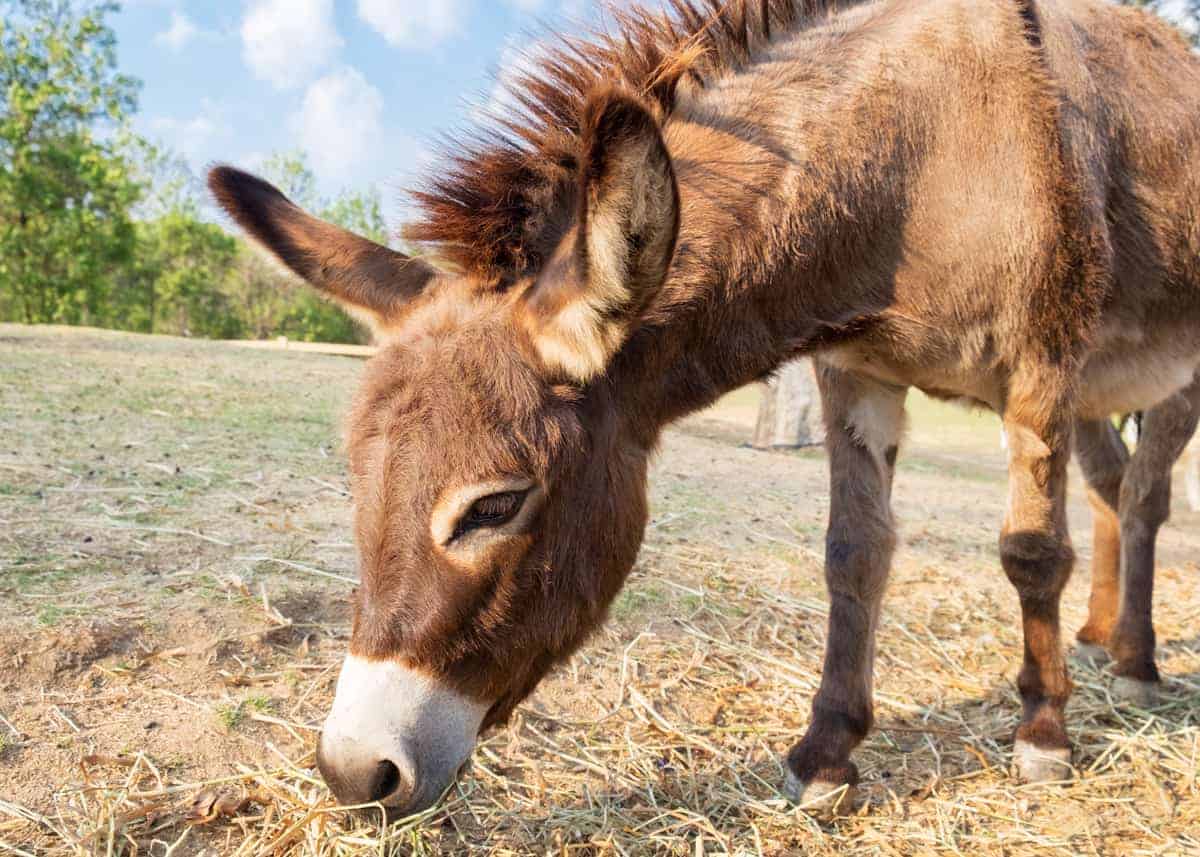
Interested in regular-sized donkeys too? You’ll love these 43 donkey facts.
27 Facts About Miniature Donkeys
The miniature donkey is one of the cutest animals in the world, so it should come as no surprise that they’re frequently paraded around farms, carnivals, and showcases. They’re also quite popular as pets and companions for both humans and other animals.
Before you start dreaming of your own miniature donkey, however, you should learn a little more about them. There are some surprising things that you’ll want to know before you grab the nearest foal and put it in a cute little hat!
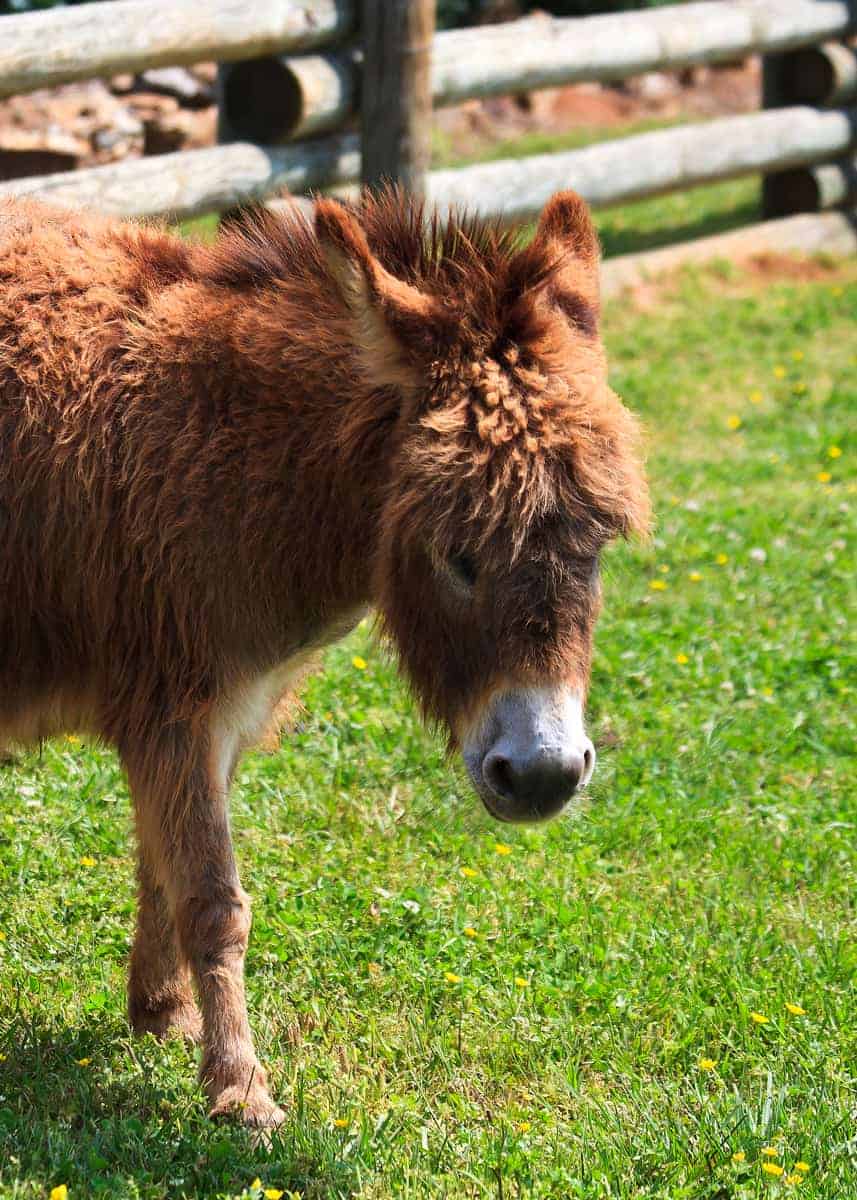
Let’s get started with a few fun miniature donkey facts.
1. What is a miniature donkey?
Miniature donkeys are a specific kind of Mediterranean donkey. As their name suggests, they’re much smaller than regular donkeys.
To be officially recognized as miniature, the animal has to measure no more than 36 inches and weigh between 200 – 400 pounds.
For comparison’s sake, a regular donkey measures 36 – 48 inches and weighs around 400 – 500 pounds. So miniature donkeys can be literally half the size of a regular donkey!
2. Are miniature donkeys a separate species from regular donkeys?
Not quite. All donkeys are classified as equus africanus asinus, including the miniature donkey. However, they’re a special and particular breed that shouldn’t be confused with small donkeys in general.
You can’t just point to the runt of a litter and say, “That’s a dwarf donkey.” There’s an entire process for breeding and registering them.
3. What’s the difference between a miniature donkey and a dwarf donkey?
There’s no difference. Miniature donkeys are also known as dwarf donkeys.
4. How do you register a miniature donkey?
A miniature donkey is registered through the American Donkey and Mule Society (ADMS). Owners can also go through the International Miniature Donkey Registry (IMDR), which is meant for miniature donkeys only.
The donkeys will need to be measured and microchipped before they’re officially considered minis. If they’re too big, they’ll be classified as “standard” donkeys rather than miniature ones.
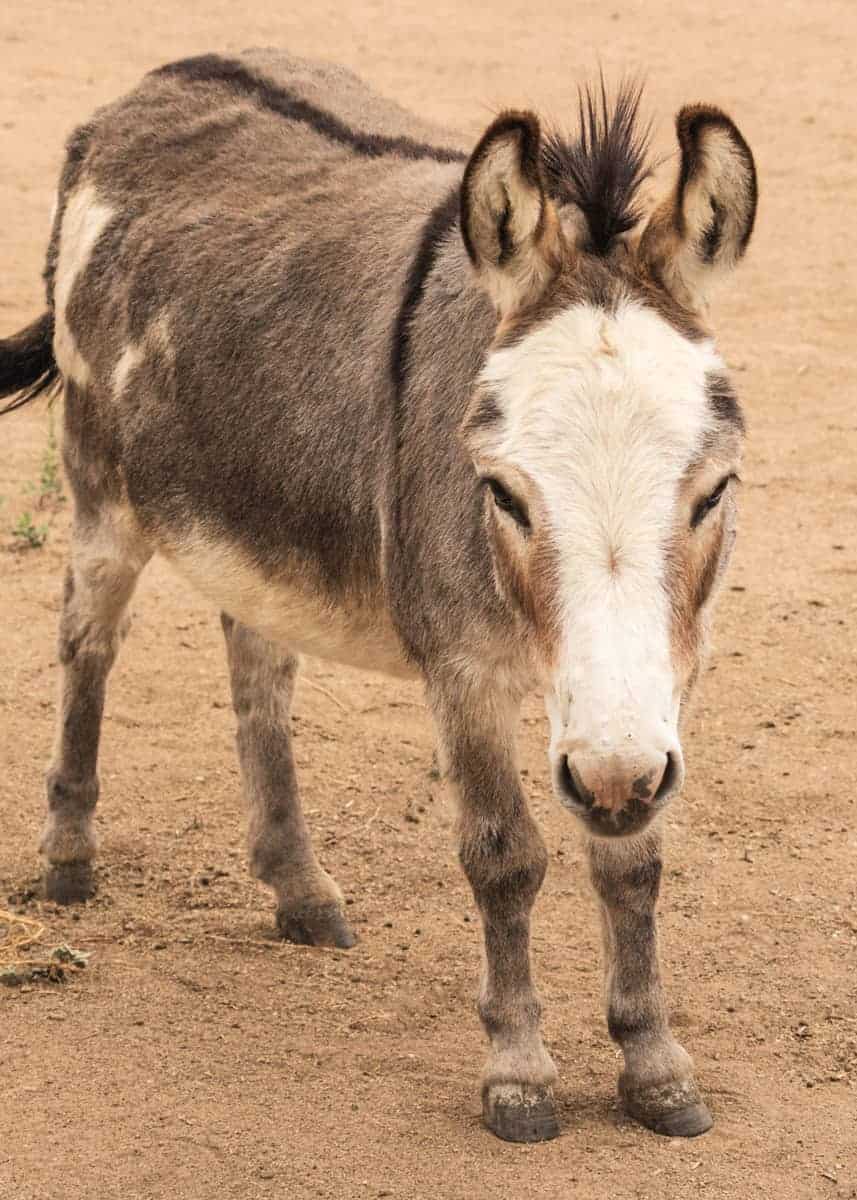
5. What’s the history of the miniature donkey?
Miniature donkeys came from the islands of Sicily and Sardinia. They were probably native species to the area, and they were used for things like carrying firewood, delivering parcels, and tending to livestock.
Sometime in the 1920s, the miniature donkey was exported to the United States, and that’s when their popularity really took off. They were used for farm labor; they were put in fairs and horse shows. The U.S. and Canada couldn’t breed them fast enough.
Today, there are only a small number of miniature donkeys living in their native European home. They’re mostly bred in North America and shipped to other countries.
6. What does the miniature donkey look like?
Mini-donkeys come in various shades of grey, brown, tan, and black. They might also have light-colored spots on their bodies or muzzles.
In terms of build, they’re virtually indistinguishable from regular donkeys except for their smaller size.
They have thick chests, strong legs, and “cow-hocked” hooves that are gently angled in opposite directions.
This is a feature of draft animals that are bred for carrying heavy loads: Their legs are positioned slightly outwards to help them evenly distribute their weight. Even though mini-donkeys carry lighter burdens than their cousins, they’re still cow-hocked at birth.
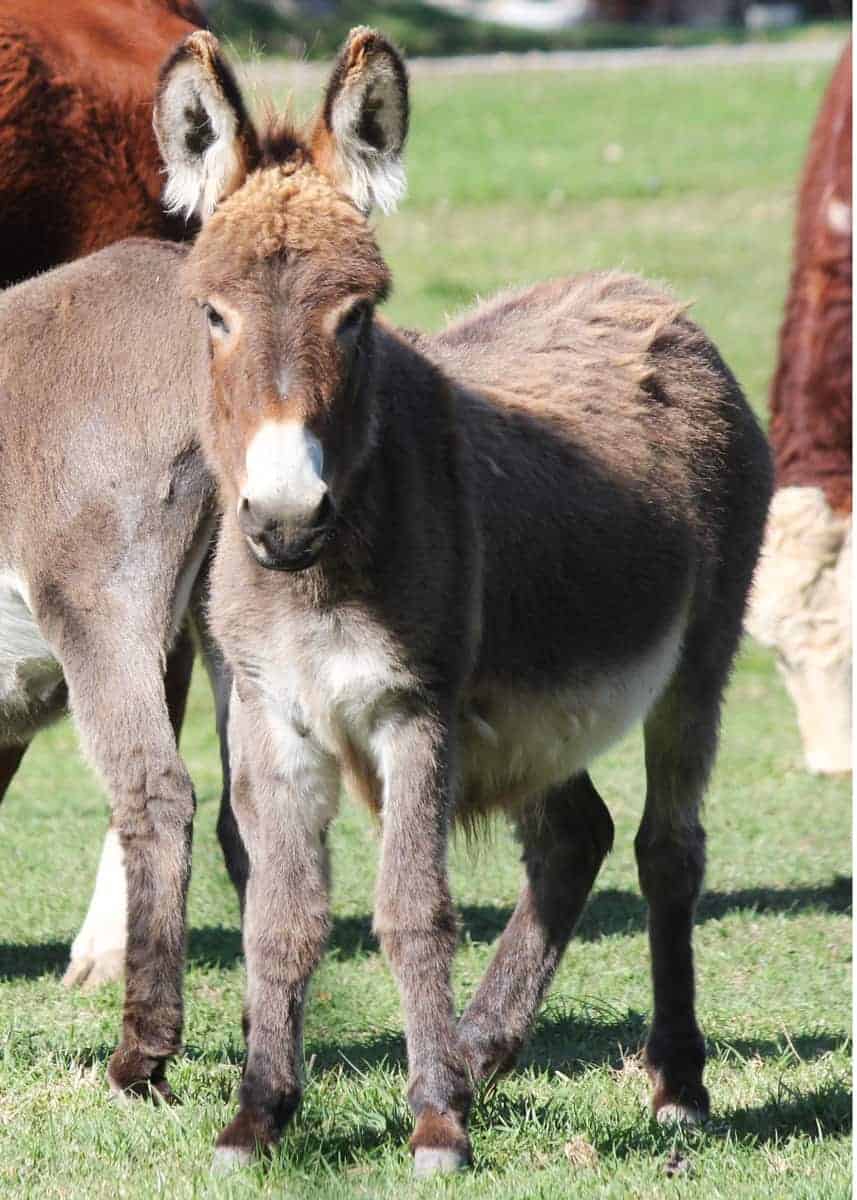
7. Do dwarf donkeys make good pets?
Dwarf donkeys make fantastic pets.
They’re completely domesticated as a breed, and they’re friendly, loyal creatures who will form attachments to their caregivers just like dogs and cats. Their soft fur makes for pleasant belly rubs, and their curious ears will stand up straight when you offer them a treat.
Many owners report their mini-donkeys to be sweet, gentle, curious, playful, and highly trainable.
8. Is the miniature donkey safe to be around?
Yes. Miniature donkeys are placid animals. You might want to watch them around very young children just because of their heft, but they’re completely open to hugs and cuddles from people of all ages.
The National Miniature Donkey Association (NMDA) even promotes them as a healing presence for the sick, elderly and handicapped.
The organization takes them around children’s hospitals and nursing homes so that people in need can enjoy an affectionate nuzzle from a friendly creature.
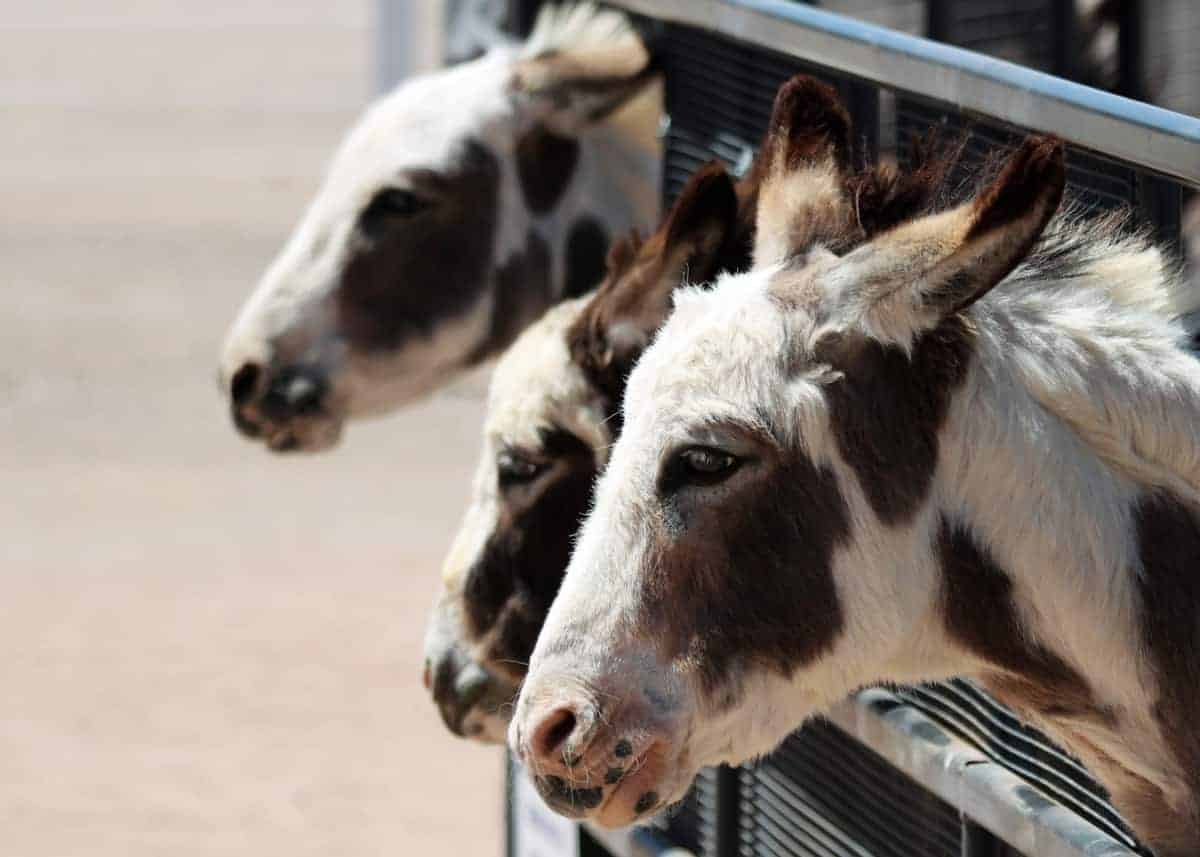
9. Can a miniature donkey live indoors?
It isn’t recommended for dwarf donkeys to live indoors.
They might not object to bunking in a stable during a cold night or rainstorm, but they’re most comfortable in open, grassy areas like fields and pastures. This is their natural habitat, and it’s where your miniature donkey will want to spend most of their time.
10. How small is the miniature donkey?
Most mini-donkeys are between 32-34 inches from their hooves to their withers. Some are smaller, but a few are bigger.
To be officially registered as a miniature donkey, they can’t be more than 36 inches tall. At that height (36 inches), they become a small but regular donkey, and they start to be measured by hands rather than inches.
11. How much does the miniature donkey weigh?
This is one of the most surprising facts about the miniature donkey. Even though they’re cute and compact, they still weigh between 200 – 400 pounds.
You can’t put them in a bag and carry them around like a chihuahua. They’re thickly-built animals that were bred for work even if you’re treating them like pets instead.
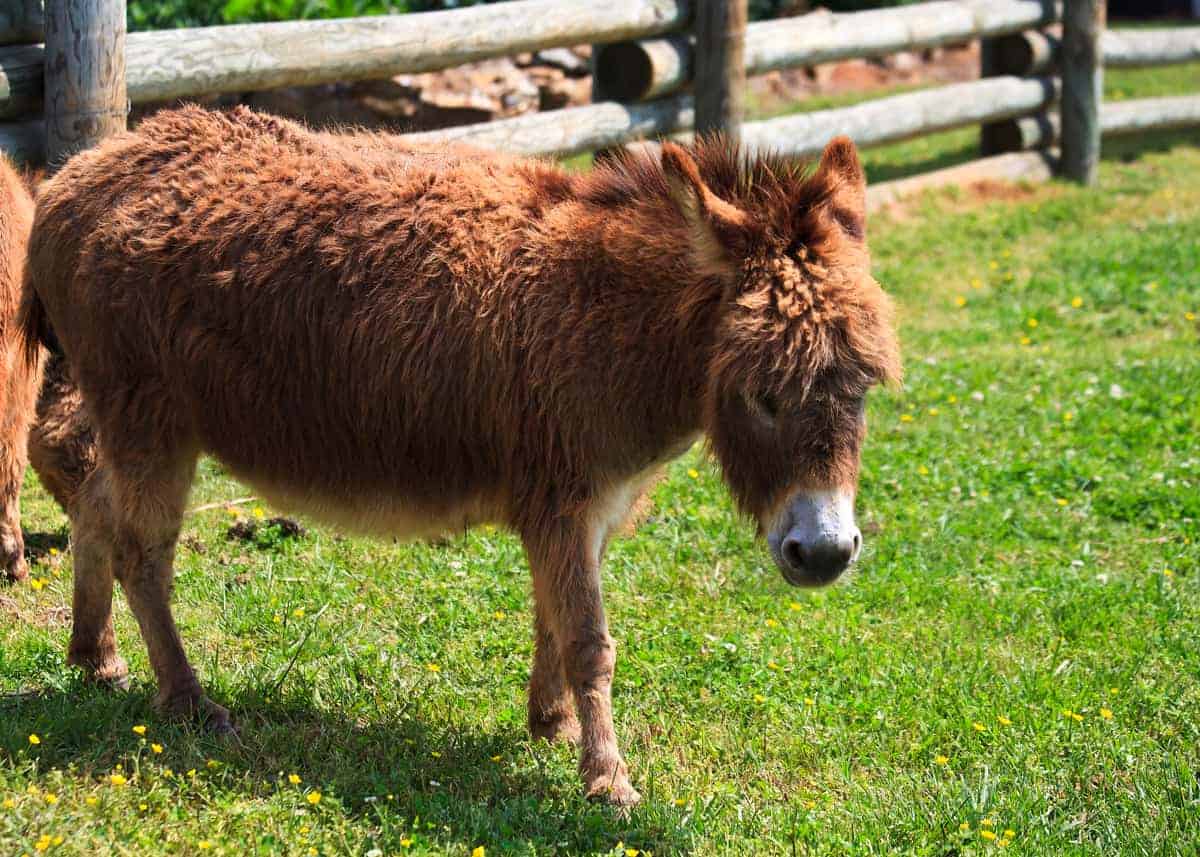
12. What’s the size of the smallest miniature donkey in the world?
Meet KneeHi. Measuring just 25.29 inches tall, he’s the smallest miniature donkey in the world. He lives on a farm in the U.S. and lets tourists take photos with him. He’s even been recognized by the Guinness Book of World Records for his itsy-bitsy size.
13. What do miniature donkeys eat?
As herbivores, mini-donkeys like grasses and grains. They’ll also take to hay if they’re being raised on a farm. They don’t go for meat products at all; they have large, flat teeth that are designed for chewing plants, so even if they were interested in a porterhouse steak, they wouldn’t know how to eat it.
Mini-donkeys also love treats. They’ll eat all kinds of fruits and veggies, including apples, oranges, pears, carrots, beets, and turnips. They’ll eat whole bananas straight from your hand with the peels still attached.
Donkeys are also fond of sweet things like molasses, but these should be kept as occasional treats instead of everyday foods.
14. Can a miniature donkey pull a cart? How much weight can they handle?
Dwarf donkeys were bred for work, so they can pull carts and transport goods just like their bigger cousins. They simply have to do it in smaller quantities.
They can’t carry more than 50 – 100 pounds without being at risk for injury, so rather than hauling around rock and iron, they’re better suited for things like delivering parcels or carrying luggage for backpackers.
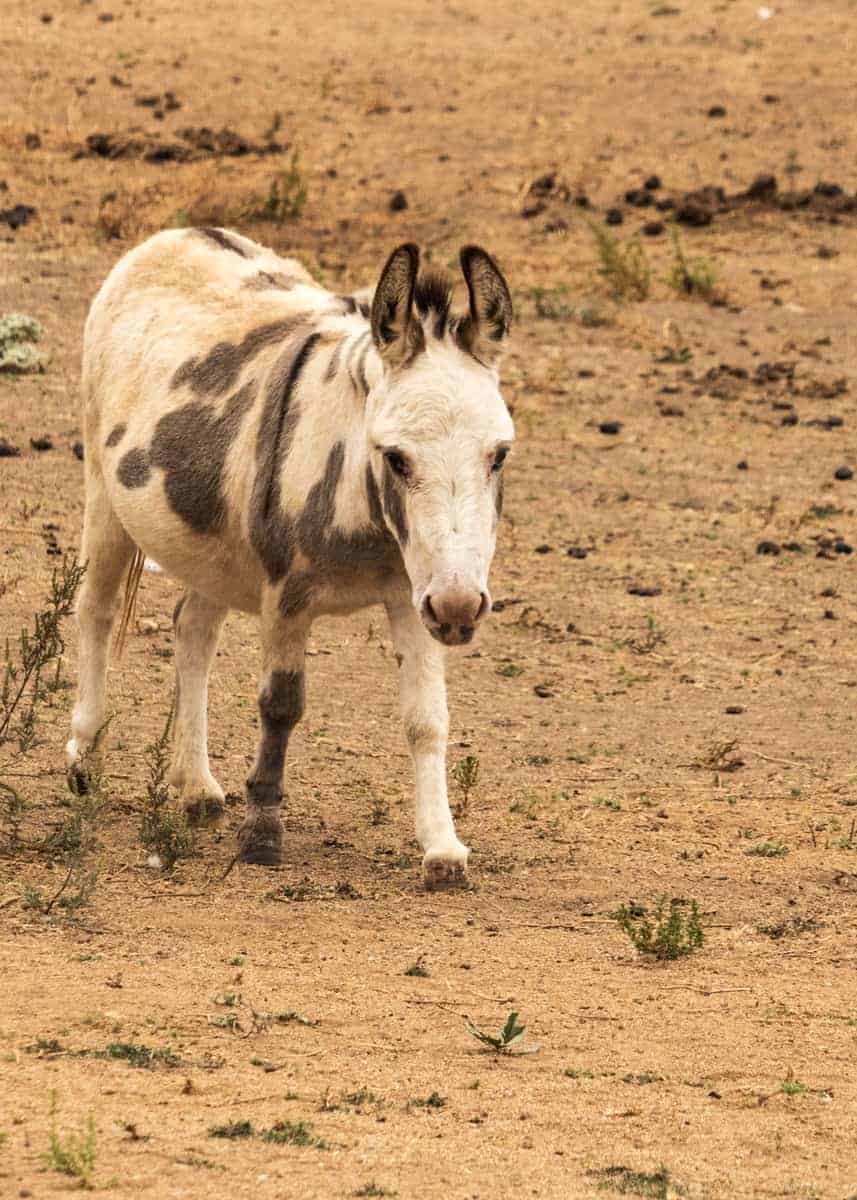
15. Can you ride a miniature donkey?
It depends. Since their weight limit is around 50 – 100 pounds, they can’t carry an average-sized adult. However, kids and pets can catch a ride on a miniature donkey whenever they like. Donkeys are bred for riding, pulling, and carrying, so they won’t mind at all.
16. How long can a miniature donkey live in captivity?
Given proper care, a miniature donkey will live for around 25-35 years. Since they’re a domesticated breed, they don’t have any of the struggles that feral donkeys face in the wild.
Most mini-donkeys are pampered pets, so they tend to enjoy long, full lives with access to food, shelter, and medical assistance whenever they need it.
17. Can you house-train a miniature donkey?
It’s not very common, but there have been mini-donkeys who were successfully house-trained.
Such was the case with Tiny Tim, a miniature donkey in Canada. He was a small, sickly foal who was rejected by his mother at birth, so his owners took him inside and raised him along with their dogs. Tiny Tim plays fetch, sleeps in a bed, and lets his humans know when he needs to do his business outside.
See the full story of Tiny Tim – the donkey that thinks he’s a dog.
18. Can you dress up a miniature donkey?
Yes. Miniature donkeys will tolerate all kinds of cute, silly costumes, so people frequently dress them up like dogs in sweaters. These outfits can be quite the attraction at public events like fairs and horse shows.
19. What are the downsides of owning a miniature donkey?
As with any animal, there are both pros and cons to owning a miniature donkey. For example, a lot of mini-donkey owners are surprised to learn that their small, sweet animal can also be quite stubborn and headstrong when they feel like it.
This is a feature of all donkeys, and when a 300-pound animal is digging in their hooves and refusing to pull your cart, there isn’t much that you can do about it!
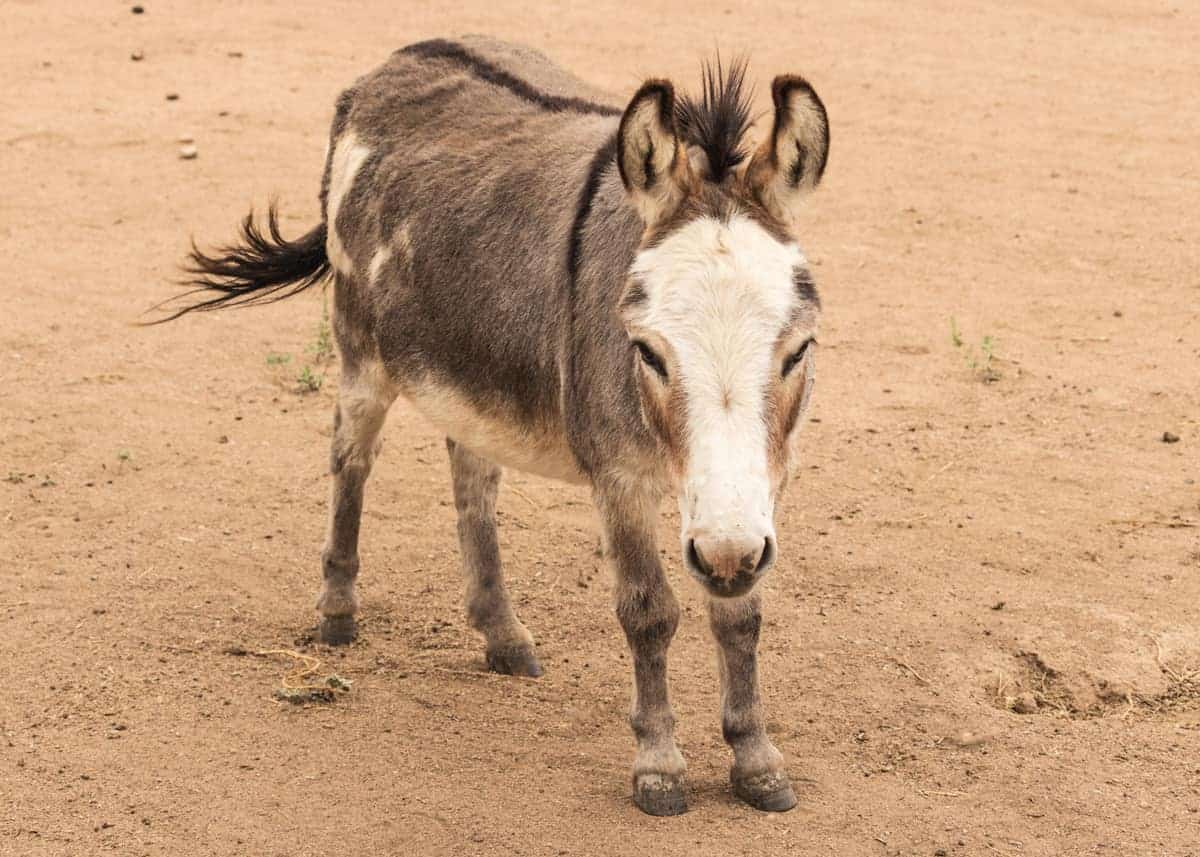
20. What are the uses for a miniature donkey?
Mini-donkeys are very trainable, so they’re used for a variety of tasks in a variety of environments:
- Companionship. Dwarf donkeys are often bought and sold as pets. People will keep them on the farm to play with their kids or serve as companions for horses, ponies or other donkeys.
- Showmanship. Their cute appearance and gentle nature mean that mini-donkeys are a popular feature at rodeos, horse shows, birthday parties, and petting zoos. They’re also great helpers at outdoor tourist attractions.
- Breeding. Donkeys can be bred with several other species to create hybrids. For example, male donkeys and female horses create mules, and female donkeys and male horses create hinnies. Mini-donkeys can also be bred to create more mini-donkeys, and since they’re in high demand, it can be a lucrative business.
- Labor. Though they can’t handle the same burdens as your typical donkey, mini-donkeys are still hard workers. They can push carts, carry tools, transport goods and give rides to children. They’re used in all kinds of farms and villages for everyday tasks.
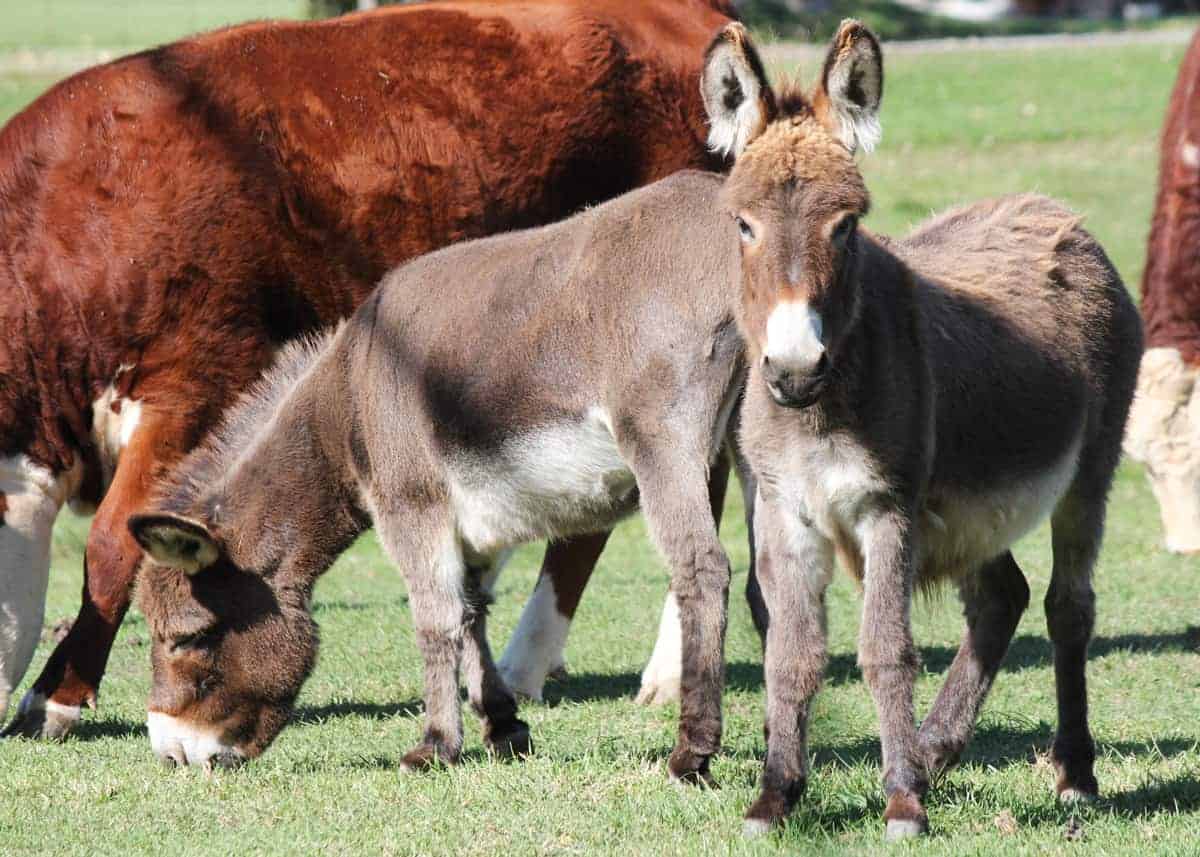
21. Will a miniature donkey protect livestock?
It depends.
As a breed, donkeys make excellent guardians for livestock. They have a natural dislike of coyotes, foxes, and wild dogs, and they won’t hesitate to stomp on any trespassers that try to slink into the pasture and kill a sheep. They also have very strong herding instincts, so they’ll keep the flock together as a matter of course.
On the other hand, dwarf donkeys are a lot smaller than regular donkeys. They might not be able to defend livestock with the same ferocity as their bigger, heavier cousins.
If you’re considering the purchase of a miniature donkey for your farm, you might want to use them as a supplemental means of protection instead of your primary one.
22. How often does a miniature donkey come into heat?
Female donkeys are called jennies or jennets, and they can come into heat at any time of year. It usually lasts for 3 – 4 weeks or until the jennet becomes pregnant.
A fun fact about jennets is that they’re known to “chew” when they’re in heat. Their mouths will open and close like they’re munching on a snack, but in reality, there’s nothing there.
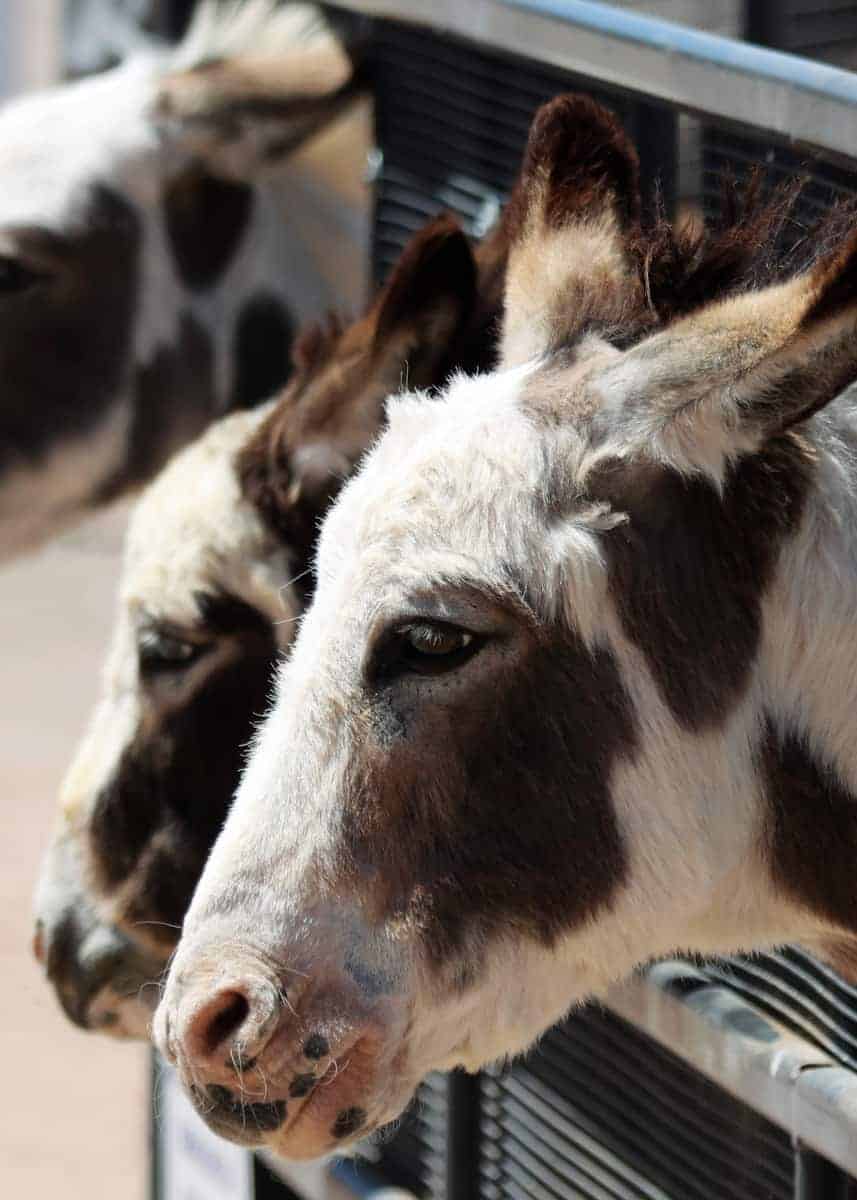
23. How long is a miniature donkey pregnant?
Donkeys have one of the longest gestation cycles in the world, and this includes miniature donkeys. Their pregnant for anywhere between 10-14 months.
They usually have a single foal, but the occasional donkey will give birth to twins.
24. What are young mini-donkeys like?
Baby donkeys are very cute animals, and the baby mini-donkey is extra cute. They weigh just 10 – 20 pounds at birth, and they’re sweet little creatures covered in fuzz who will make plaintive noises at their mother until she herds them close to begin nursing.
This happens very quickly after birth; jennets will begin nursing their foals just a few minutes after delivering them. Moms will also stick close to their babies for several months after that. They won’t even go into heat again until after their foals have matured a little.
25. What’s the difference between a miniature donkey and a miniature horse?
Donkeys and horses are entirely separate species. They can be bred together to create hybrids, but they have their own distinct colors, sizes, diets, temperaments, and habits.
They even have their own chromosome counts: Donkeys possess 62 chromosomes while horses boast 64.
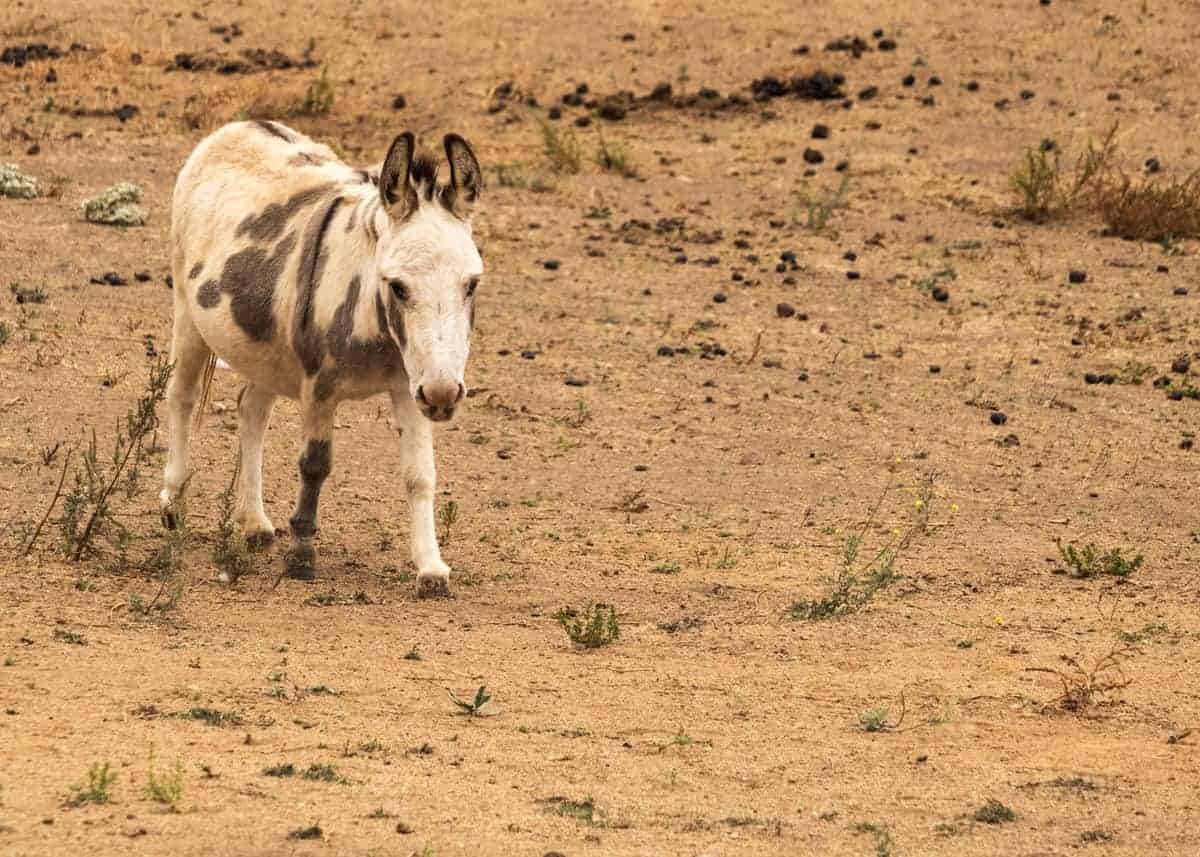
26. How smart are dwarf donkeys?
Dwarf donkeys are quite intelligent. They can be trained in all kinds of labor, and they’re also quite adept at learning things like obstacle courses.
This is one of the reasons why they’re so popular at carnivals and animal shows. When properly motivated by treats and training, they can be real crowd-pleasers.
27. How much does a miniature donkey cost?
If you’re interested in buying a miniature donkey, you should know that they’ll cost you anywhere from $500 – $2,000. Their ultimate price tag will depend on things like age, gender, and size. A healthy female who is ready to breed will be more expensive than a retired, gelded male.
Registration also matters. A miniature donkey who is officially recognized as such will be much more valuable than a mini-donkey who hasn’t been measured and approved by the ADMS or IMDR.
Remember: You can’t just say that any small donkey is a miniature donkey. They have to meet certain qualifications to be registered that way.
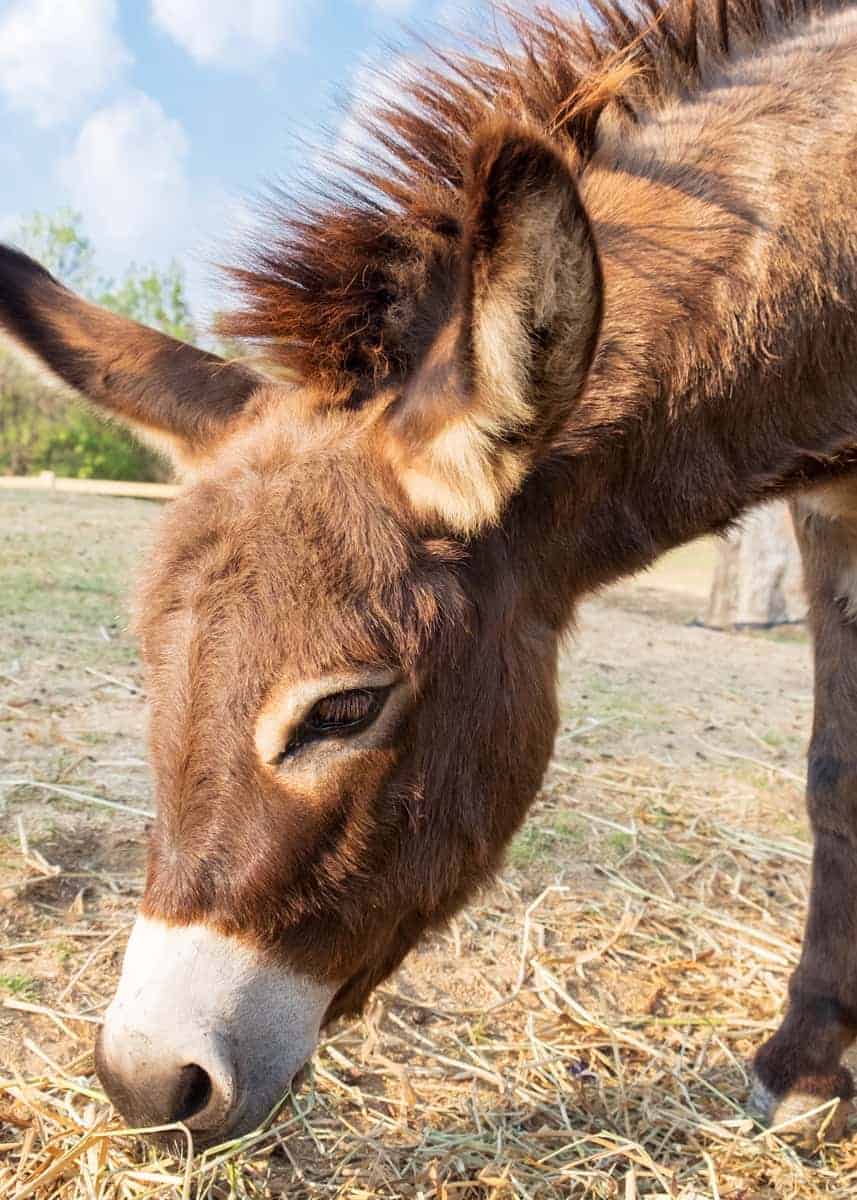
Want more cute animals? Check out this post about kangaroo diets.
Delightfully Dainty Dwarf Donkeys
Did you learn anything from these miniature donkey facts? They’re still surprising owners and researchers every day, so you aren’t alone. As they expand in both population and popularity, mini-donkeys are being studied more and more, so expect this list of trivia to keep growing!

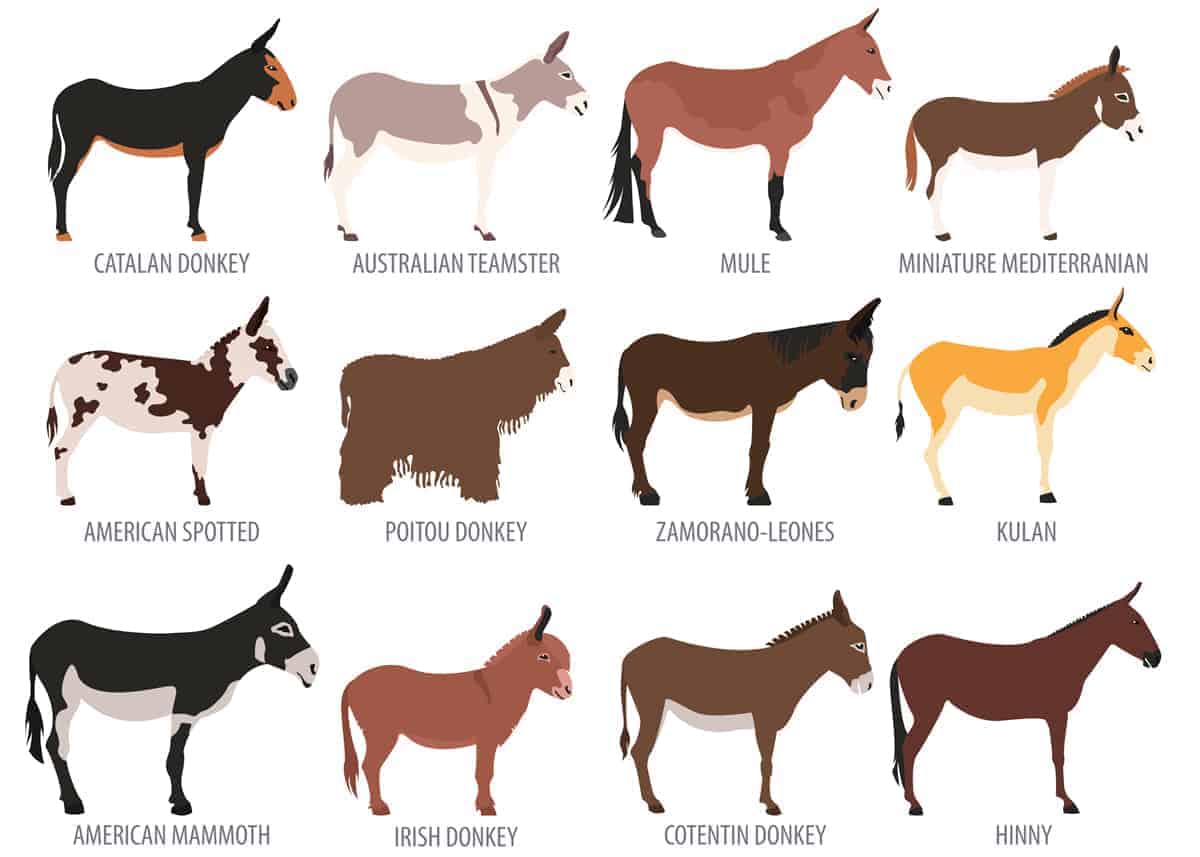






Nothing on quantity of food or poop a day?
i love the min donkeys there so cute i want one as a pet im retired and have very much time to give i live in albany ga i have 2 acres fenced in
Where in coastal NC to look to purchase a tame mini donkey
I’m looking to buy a miniature donkey. Can you tell me where I can look in New Jersey?
I am interested in buying a donkey near Lapeer Michigan I would like a female light in color and I want to buy it in the spring I have 12 acres that are fenced in
I live in Lapeer Michigan I am very interested in buying a miniature donkey a female In the spring I would like a light colored one
I am very interested in buying a miniature donkey. I live in cambria. Lots of land and space.
How old are the miniature donkeys before they leave their mothers
I would not breed them so could 2 males or 2 females get along
Why do u say u wouldn’t breed them?
@Laylee, maybe Dorecia realizes that there are MANY donkeys already born who need homes! My goodness, there are so many donkey rescues who need responsible owners to home the ones they have. Just like dogs and cats, at this point people should help take care of the ones who need homes instead of the constant flow of newly born animals either by irresponsible “owners” or well meaning but unnecessary breeders of animals. Answer to Dorecia; Yes! The sweet little donkeys get along great in almost all cases but the “jacks” need to castrated to become geldings to avoid dangerous fighting and random breeding due to instinct!
@Jan Horton, I live in Hampstead NC. 28443 are there any adoption places for mini donkeys near me I’m 76 would they be a great therapy companion, elderly like me is fine we would have a lot in common lil they are so adorable
Thank you for this fabulous article. Can you please direct me to a reputable seller of miniature donkeys in western North Carolina. Thanks! Jan